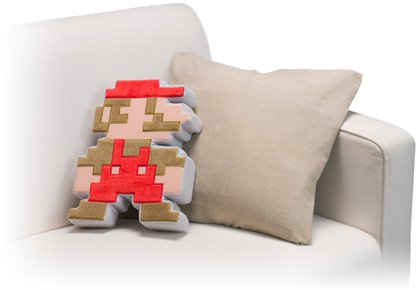
submitted by Yarik32 to funny
[link] [454 comments] [a5.sphotos.ak.fbcdn.net]
 The Japanese Club Nintendo seems to have cooler swag to redeem when compared to the US Club Nintendo, and their latest offerings are no exception. One of the recently revealed redeemable gifts from Club Nintendo Japan is the Dot Mario Cushion: an 8-bit Super Mario cushion which takes gamers back to the year 1985 where Super Mario was a pixilated hero running around on NES-connected TVs.
The Japanese Club Nintendo seems to have cooler swag to redeem when compared to the US Club Nintendo, and their latest offerings are no exception. One of the recently revealed redeemable gifts from Club Nintendo Japan is the Dot Mario Cushion: an 8-bit Super Mario cushion which takes gamers back to the year 1985 where Super Mario was a pixilated hero running around on NES-connected TVs.
The other rewards include a Nintendo 2012 desk calendar and five video game soundtracks (Tomodachi Collection, Pilotwings Resort, Star Fox 64 3D, Wii Fit Plus, and Mario Kart Wii). Folks with 400 points can redeem the Dot Mario Cushion, though you’ll need to be a member of the Japanese Club Nintendo. Definitely the perfect addition to any gamer’s couch.
Dot Mario Cushion is the perfect cushion for Mario fans, By Ubergizmo. Top Stories : Epic 4G Touch Review, Galaxy S2 Review,
 The Japanese Club Nintendo seems to have cooler swag to redeem when compared to the US Club Nintendo, and their latest offerings are no exception. One of the recently revealed redeemable gifts from Club Nintendo Japan is the Dot Mario Cushion: an 8-bit Super Mario cushion which takes gamers back to the year 1985 where Super Mario was a pixilated hero running around on NES-connected TVs.
The Japanese Club Nintendo seems to have cooler swag to redeem when compared to the US Club Nintendo, and their latest offerings are no exception. One of the recently revealed redeemable gifts from Club Nintendo Japan is the Dot Mario Cushion: an 8-bit Super Mario cushion which takes gamers back to the year 1985 where Super Mario was a pixilated hero running around on NES-connected TVs.
The other rewards include a Nintendo 2012 desk calendar and five video game soundtracks (Tomodachi Collection, Pilotwings Resort, Star Fox 64 3D, Wii Fit Plus, and Mario Kart Wii). Folks with 400 points can redeem the Dot Mario Cushion, though you’ll need to be a member of the Japanese Club Nintendo. Definitely the perfect addition to any gamer’s couch.
Dot Mario Cushion is the perfect cushion for Mario fans, By Ubergizmo. Top Stories : Epic 4G Touch Review, Galaxy S2 Review,


The Mexican Mafia is a fairly small prison gang (perhaps 150-300 made members) and it has significant operational control only within  prisons in Southern California yet the Mexican Mafia is extremely powerful. In fact, the MM taxes hundreds of often larger Southern California street gangs at rates of 10-30% of revenues. How can a prison gang tax street gangs? In Governance and Prison Gangs (also here), a new paper in the APSR, David Skarbek explains the structure, conduct and performance of the Mexican Mafia.
prisons in Southern California yet the Mexican Mafia is extremely powerful. In fact, the MM taxes hundreds of often larger Southern California street gangs at rates of 10-30% of revenues. How can a prison gang tax street gangs? In Governance and Prison Gangs (also here), a new paper in the APSR, David Skarbek explains the structure, conduct and performance of the Mexican Mafia.
The key to the MM’s power is that most drug dealers will sooner or later, usually sooner, end up in prison. Thus, the MM can credibly threaten drug dealers outside of prison with punishment once they are inside prison. Moreover, prison is the only place where members of many different gangs congregate. Thus, by maintaining control of the prison bottleneck, the MM can tax hundreds of gangs.
One of the most interesting aspects of Skarbek’s analysis is that he shows–consistent with Mancur Olson’s stationary bandit theory–that as the MM grew in power it started to provide public goods, i.e. it became a kind of government. Thus, the MM protects taxpayers both in prison and on the street, it produces property rights by enforcing gang claims to territory and it adjudicates disputes, all to the extent that such actions increase tax revenue of course. The MM is so powerful that it often doesn’t even have to use its own enforcers; instead, the MM can issue what amounts to a letter of marque and reprisal, a signal that a non-taxpaying gang is no longer under its protection, and privateers will do the rest.
The MM even internalizes externalities:
In addition, the Mexican Mafia regulates drive-by shootings…because any particular street gang only suffers a portion of the increased attention of law enforcement from drive-by shootings, each street gang has an incentive to do too-many (Buchanan 1973). In 1992, Mexican Mafia members sent notes throughout the prison system and Sureño neighborhoods that any gang member participating in an unauthorized drive-by shooting would be killed. Shortly after the Mexican Mafia announced this rule, drive by shootings declined.
The Mexican Mafia has much to teach us about crime and governance.